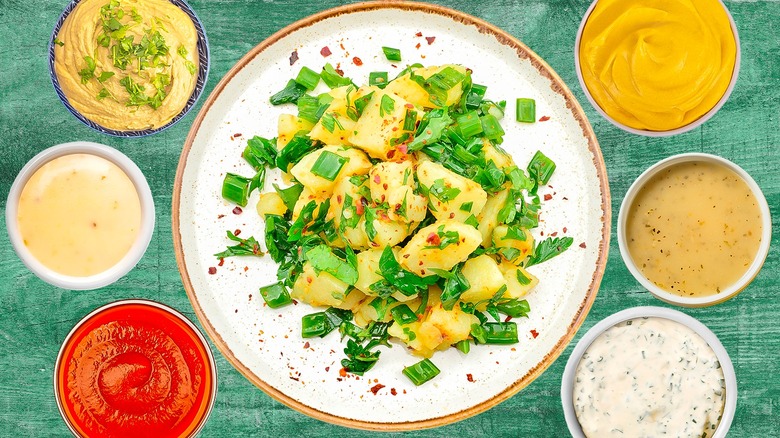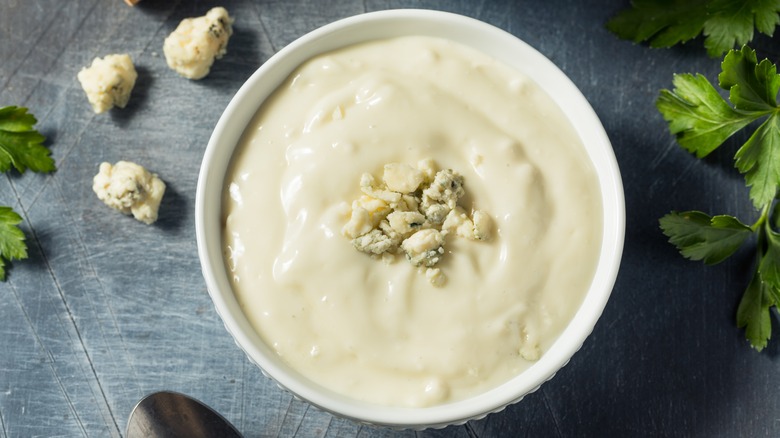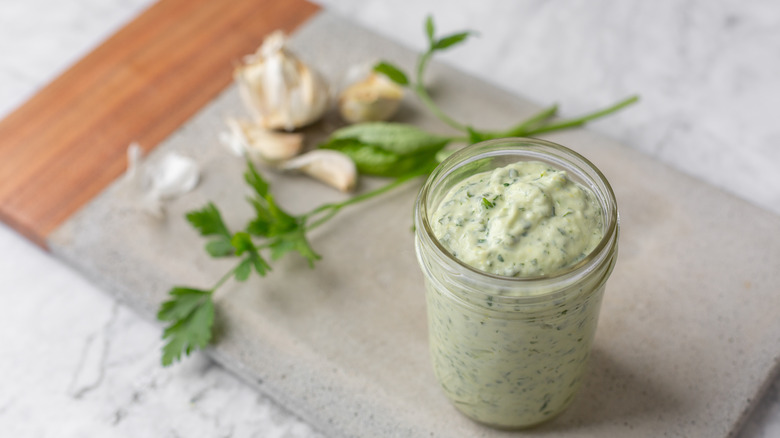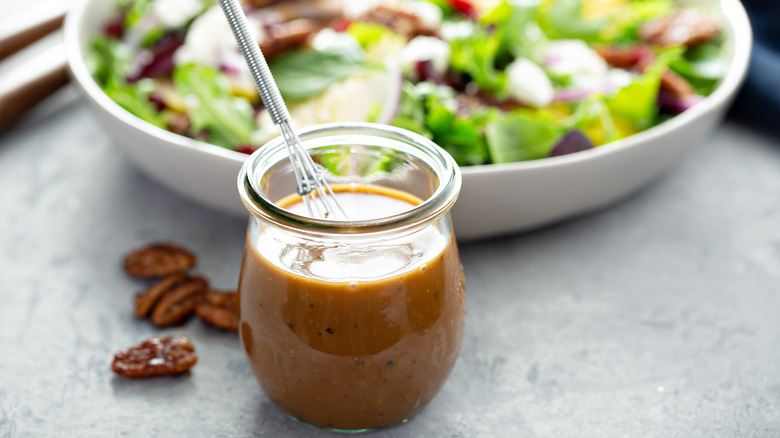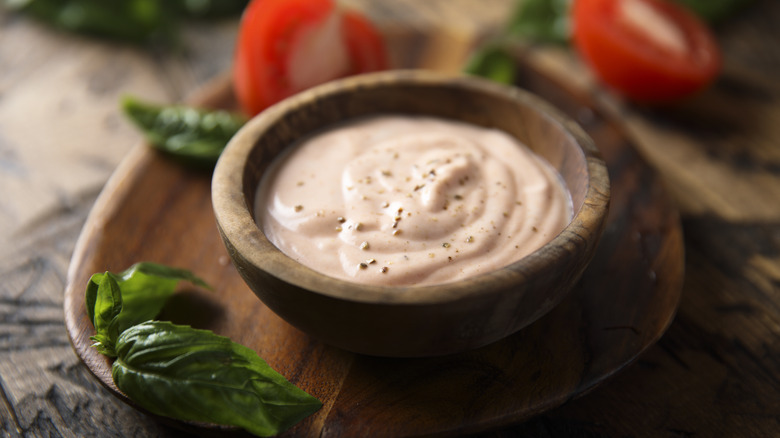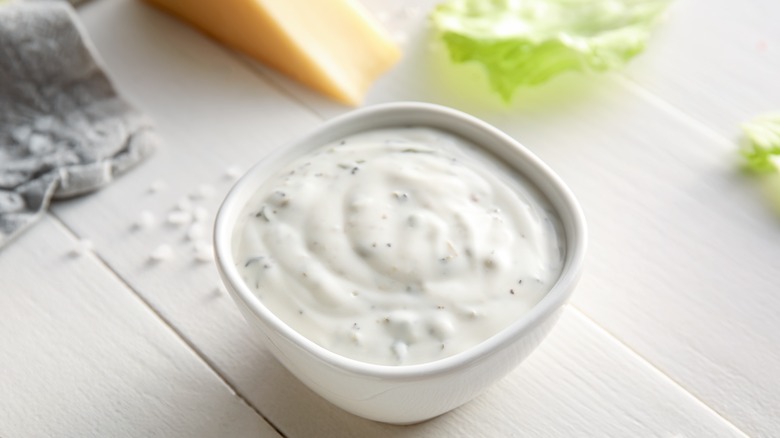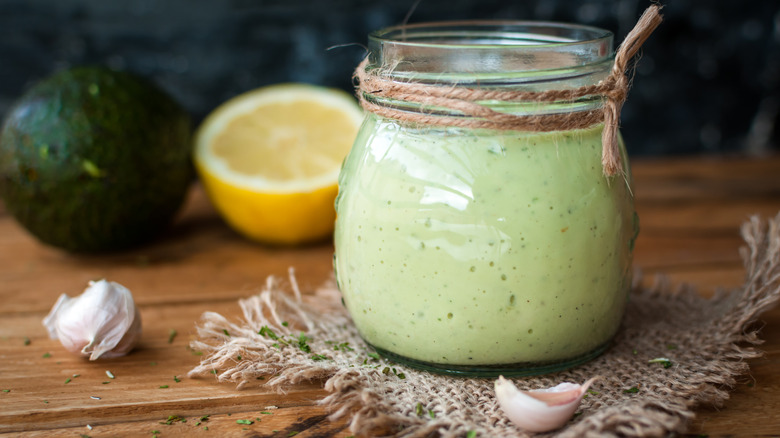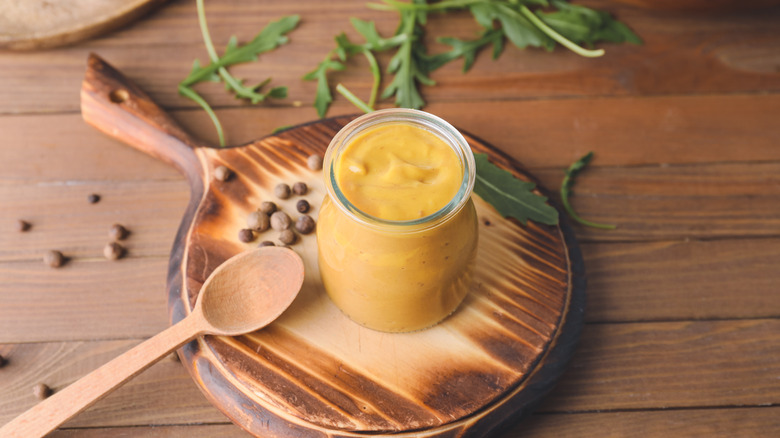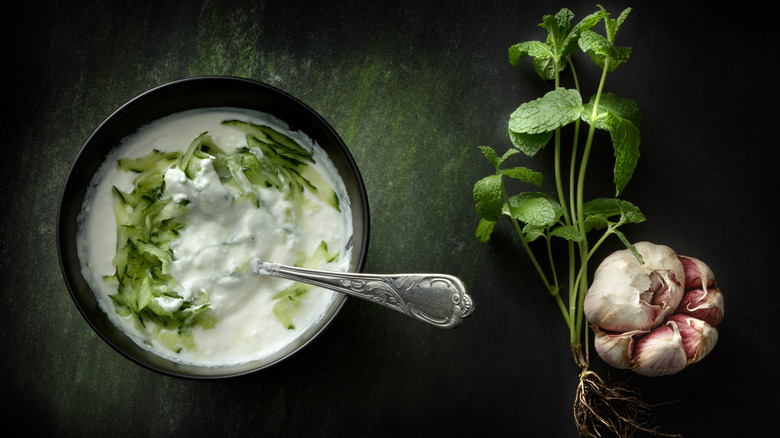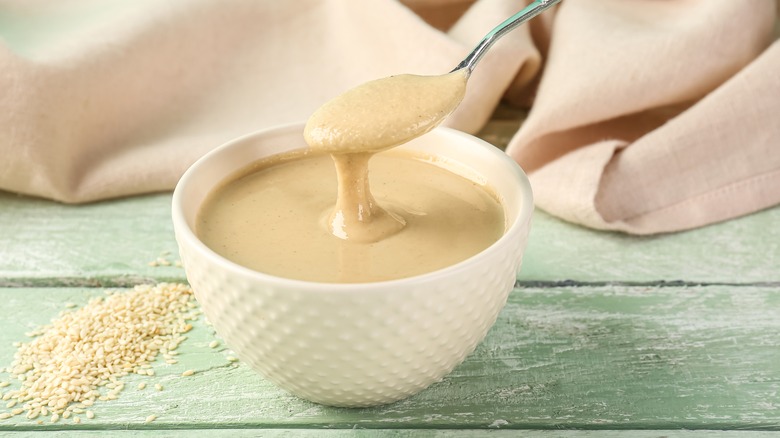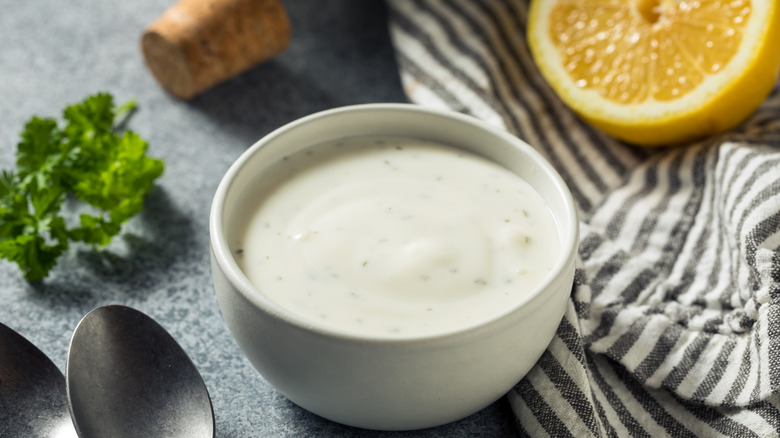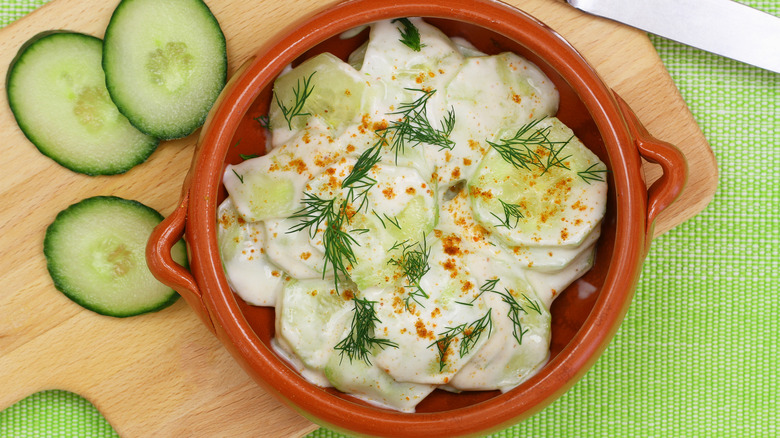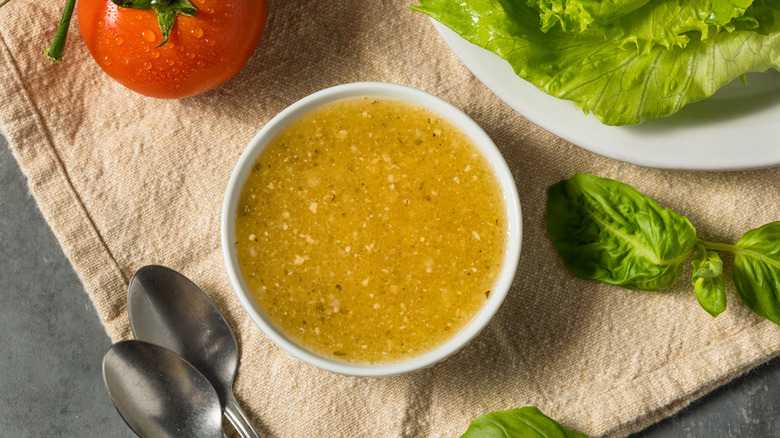13 Best Dressings For Potato Salad
There are few potluck staples as versatile as potato salad. Switch up the herbs, add in some new flavor enhancers, or even change up the type of spud you use and you've got an entirely new side dish to share with friends and family.
When it comes to whipping up a winning bowl of potato salad, there are a few tried-and-true tricks to have up your sleeve. First and foremost is choosing the right spud. Waxy varieties like new potatoes, fingerlings, and red potatoes are often considered the best type of potatoes for classic recipes due to their low starch and high water content. This combination of attributes helps these potatoes maintain their shape through all the boiling and mixing that goes into making the dish. As an added bonus, they typically don't need to be peeled.
Other equally important tips for making the absolute best potato salad include steaming your spuds to prevent a watery final product, adding the dressing while the potatoes are still warm (but not hot) for maximum flavor absorption, and tossing in crunchy elements like raw veggies for a satisfying textural contrast.
There's a lot to consider when making the perfect potato salad, from the spuds to the mix-ins. But the flavorful glue that ties it all together is the dressing. Creamy, earthy, vinegary, or umami, these dressings just might elevate your next batch of potato salad from boring to mindblowing.
Blue cheese dressing
Possibly the most polarizing flavor in salad lore, blue cheese dressing deserves a seat at the potluck table for its distinctively pungent punch and crumbly texture. Creamy and tangy, blue cheese lends itself to classic potato salad recipes for its satisfying texture while also elevating the picnic staple with extra richness.
Before turning your nose up at the classically stinky cheese, consider that not all blues are created equal. There's a common myth that all blue cheese is overpowering in both odor and flavor but the reality is that the range of blue cheeses on the market is as varied as the tones on a color wheel. For a mild introduction to the pungent world of blues, try tamer varieties like Spanish Queso La Parel, Ireland's Cashel Blue, or a brie-gorgonzola hybrid called Cambozola.
The best way to ensure a dressing that suits your personal taste is to make your own — a task that isn't quite as daunting as it may seem. Once you've picked out your preferred blue cheese, consider the other dairy products you could use to create that creamy, tangy base without overdoing it on the pungent cheese. Mayo is the classic choice, but Greek yogurt or buttermilk also make excellent additions to the traditional recipe. A clove of garlic, a squeeze of lemon, and a handful of freshly chopped parsley are all you need to finish off the dressing.
Green goddess dressing
Creamy and refreshing, green goddess dressing works wonders over chunky boiled potatoes. Earthy flavors like fresh herbs and spinach rounded out with zing from lemon juice and garlic put a mouthwatering spin on classic potato salad while adding an extra dose of Vitamin C. Add in some extra crunch with celery or radish to keep that gorgeous green color palette front and center.
Green goddess' staying power is practically immortal as far as dressings go. The 100-year-old recipe was first introduced in the dining room of San Francisco's Palace Hotel in the 1920s as a tribute to the popular play of the moment, "The Green Goddess." While the recipe has evolved over the years — the original was a mayo-heavy mix served over a canned artichoke — the modern iteration is a tangy green delight that pairs perfectly with hearty neutral potatoes.
Easy enough to whip up in a blender, the classic recipe calls for ice, pasteurized eggs, whole grain mustard, shallots, capers, chives, spinach, fresh tarragon, tarragon vinaigrette, chopped parsley, salt, and pepper. The creamy delight is a perfect potato salad dressing as is, but those who feel iffy about using raw eggs could swap in ripe avocado to keep both the creamy consistency and that stunning green color. Another way to amp up your green goddess dressing? Add a dash of sharp Dijon mustard for a sweet and tangy twist.
Balsamic vinaigrette
Balsamic vinegar might just be the most underrated condiment in your kitchen cabinet. It's delicious drizzled over mozzarella and tomatoes, but this sweet and tart vinegar really shines with a neutral flavor canvas like steamed potatoes. For a Mediterranean twist on French-style potato salad, a quick balsamic vinaigrette is just the trick.
Typically made with Champagne vinegar and Dijon mustard, French potato salad is a tangy twist on the mayo-based versions you'll find at the average potluck. Balsamic vinegar adds a touch of sweetness to the traditional recipe due to the fact that it's made from grapes rather than wine. This fruit-based production process plus a little patience (up to 25 years' worth) is what makes balsamic vinegar different from other vinegar products.
Thanks to its uniquely bold flavor, balsamic vinegar lends itself to a wide variety of uses, in this case, as part of a mouthwatering potato salad. As with any classic vinaigrette, you'll need olive oil, Dijon mustard, garlic, salt, and pepper to complete your homemade dressing. Since this dressing is so simple, you'll want to make sure you procure high-quality ingredients. A 12-year-aged balsamic should do the trick — bottles aged for longer are best reserved for drizzling due to their significantly increased price point and syrup-like consistency.
Sriracha aioli
Smooth and creamy with a kick, sriracha aioli brings the spice your potato salad is missing. Supremely popular sriracha adds a unique heat thanks to a chili-garlic combo that works mouthwatering magic on almost anything it touches. Brought to California in 1979 by Vietnamese immigrant David Tran, the now-ubiquitous red sauce got its name from the Thai city in which it was supposedly invented before spreading to Vietnam and eventually the U.S. — the product of an international culinary melting pot.
Before you add a few squirts of sriracha to store-bought mayo, there are a few things you need to know about aioli. While both spreads are emulsions (a stabilized blend of oil and a water-based ingredient), the major difference between aioli and mayonnaise is the use of egg. Where mayo is a blend of a neutral-flavored oil like canola and egg yolk, aioli is historically made from garlic paste and olive oil. This traditional method, while delicious, is labor-intensive and prone to breakage — not exactly ideal in a busy kitchen. The addition of an egg to the garlic paste helped aioli to remain stable, hence its modern-day prevalence on restaurant menus from Michelin-star establishments to burger joints.
No matter how you make your emulsion, homemade is the way to go for maximum flavor. Simply mash a few cloves of roasted garlic, whip with lemon juice and olive oil using an electric mixer, and add a few dashes of sriracha, and voila! You've made a true sriracha aioli.
Caesar dressing
Who knew Caesar dressing could be such a satisfying pairing with classic potato salad? A starchy, neutral root veggie base lets the punchy flavors of Parmesan, garlic, black pepper, and anchovy shine through.
While the thought of adding fish to your potato salad dressing may not appeal to everyone, the meaty umami taste that tiny anchovies bring to the final product can't be denied. However, if you just can't stomach it, swap in a few dashes of Worcestershire sauce for the fish fillets. According to salad lore, this swap might be closer to the original Caesar salad recipe anyway. Looking for a lighter spin on the classic dressing? Try swapping in low- or non-fat Greek yogurt for a healthier sauce base.
No matter how you mix it up, there's one easy dressing hack that's guaranteed to elevate the flavor of your Caesar. Making your dressing a day in advance allows the flavors to meld, creating a richer final product with a deeper more mouthwatering flavor. Toss the pre-mixed sauce with warm potatoes to allow the starch to soak up all of that tangy goodness and let the salad sit in the fridge for a few hours before serving for maximum flavor absorption.
Avocado dressing
Not all potato salad recipes need mayonnaise to achieve a creamy consistency. Swap ripe avocado for mayo for the fat in your next batch to enjoy extra nutritional benefits as well as a unique, earthy flavor.
When it comes to health-conscious calorie consumption, avocados impress with their bevy of healthy fats, including omega-3 fatty acids. According to Medical News Today, the healthy fats found in avocados can keep your blood sugar stable by slowing the breakdown of carbohydrates. In layman's terms, they help you feel fuller longer.
While the health benefits are plentiful, the flavor is what most cooks are after. When using avocado as a base for potato salad dressing, texture is key. Instead of mashing as you would for guacamole, throw ripe avocados in a blender with some acid, seasonings, and fresh herbs to create your own unique concoction. For a Tex-Mex twist, go with lime, garlic, chili powder, and fresh cilantro plus a healthy dose of salt and pepper. Toss with warm potatoes, red onion, jalapeño, and garnish with an extra sprinkle of cilantro for a guacamole-inspired spin on the classic picnic stable.
Honey mustard dressing
If you find yourself constantly thinking about the Roman empire, the ancient combo of honey and mustard beloved by the Romans might just be your next potato salad winner. A mouthwatering marriage of sweet and tangy, honey mustard dressing makes your taste buds (and potatoes) sing. This easy-to-whip-up dressing will elevate your next batch of boiled spuds from side dish to showstopper.
The modern iteration of this type of salad dressing took off around the 1970s and remains a popular condiment to this day. Rather than reach for the store-bought variety, try whipping up this simple salad dressing at home for a personalized twist on the traditional recipe.
Aside from the obvious ingredients, honey mustard dressing typically contains some form of oil, acid, and a selection of spices. The simplest route would be to use mayo, a squeeze of lemon, and a sprinkle of salt and pepper, but feel free to experiment with different types of vinegar and your personal preference of spices for a completely customized version. As for those namesake pantry staples, opt for high-quality upgrades like locally sourced honey and a blend of Dijon and yellow mustard for richer flavor.
Tzatziki
For an ultra-fresh update to classic potato salad, consider swapping the mayo for tangy tzatziki. Packed with all the elements of a traditionally delicious starchy side dish (creamy base, acidic bite, fresh herbs, and crunchy mix-ins), it's a wonder this Greek condiment hasn't made its way into potato salad recipes sooner.
Thick Greek yogurt not only delivers on the flavor and texture front but its lower fat and higher protein content makes tzatziki an appealing alternative to those watching their waistlines or cholesterol intake. Not to mention, it's an easy store-bought alternative to scratch-made dressing in a pinch.
While the pre-made variety is an appealing shortcut, it's no substitute for homemade dressing. Tzatziki just requires a few fresh ingredients to deliver that tart, fresh bite that pairs so perfectly with tender cooked potatoes. Recipes vary, but most include grated cucumber, Greek yogurt, garlic, lemon juice, olive oil, and dill or mint. For added crunch, try tossing your tzatziki-coated potatoes with other Mediterranean ingredients like olives, capers, or chopped Persian cucumbers. Garnish with more fresh herbs for a bowl of potato salad that's as appealing to the eye as it is to the palate.
Tahini
To enjoy a creamy potato salad without the diary, a tangy tahini-based dressing is just the ticket. Made from sesame seeds, tahini's smooth and unctuous consistency can be compared to nut butter and is typically used as a thickening agent in Mediterranean and Middle Eastern dishes like hummus and baba ganoush. It can even be used to add a creamy, nutty element to baked goods.
When scanning store shelves, you'll want to look for the raw variety — this is the best type of tahini for raw applications like salad dressings. The toasted version has a richer flavor that's more often found in cooked dishes like noodles and soups. Raw tahini also retains more of its nutritional value, including plenty of anti-inflammatory monounsaturated fats, according to Healthline. As an added bonus, tahini is also vegan which makes it an allergen-friendly alternative to other creamy potato salad dressing options.
Tahini on its own is lovely but it needs a little help to reach potato salad-ready status. Add a squeeze of lemon for a little zing or make a super creamy dressing by blitzing in some chickpeas — that's right, we're talking hummus. Smooth homemade hummus brings a delightful texture to potato salad, made extra creamy when you use fingerling potatoes.
Ranch dressing
Few vegetables were ever made worse with the addition of ranch dressing. In fact, the dressing's origins are a testament to that fact: The recipe was whipped up by a plumber-turned-cook in Alaska who found a way to get disgruntled workers to eat their veggies. The scheme worked and that clever cook brought his recipe all the way home to his California ranch, named Hidden Valley. Yup, the origin story of Hidden Valley Ranch is the history of ranch dressing.
From humble origins rose one of America's favorite salad dressings. A creamy blend of buttermilk, mayonnaise, and dried herbs, ranch goes well with everything from lettuce and raw veggies to pizza and chicken wings, and works particularly well with starchy potato salad. The waxy potato varieties that work best in classic potato salad recipes tend to be on the dry side so fatty dressings like buttermilk ranch bring a much-needed richness and moisture to the final product that's sure to leave your tastebuds tingling.
Mixing up a batch of buttermilk ranch for potato salad is easier than you might think — it just takes a little chopping to prep your herbs. Simply combine buttermilk and mayo (swap in Greek yogurt for a lighter twist) with minced garlic, scallions, cilantro (you can skip the cilantro if you're not a fan), dill, parsley, and chives, and season with salt and pepper to taste.
Mizeria
A refreshing side dish in its own right, Polish mizeria is a creamy blend of crunchy cucumber, sour cream, and fresh dill that also happens to pair perfectly with potatoes. Similar to tzatziki, this crispy salad stars super-fresh cucumbers with dairy playing a supporting role albeit with a few additional characters.
The key to making a thick mizeria is to control the water content. Made of mostly water, the cucumber needs to be dried out before being added to the mix. To achieve a crunchy salad, sprinkle your sliced cucumber with salt and leave it alone for about 15 minutes. The salt draws out the moisture leaving behind the delightfully crispy crunch you're after. For a little extra insurance against a watery salad, squeeze out the cucumber slices in a paper towel to remove any remaining liquid.
To make the dressing, combine lemon juice, white vinegar, chopped dill, salt, pepper, and a touch of sugar. Traditional mizeria uses whole cucumber slices, but to transform the dish into a dressing, you could chop the cucumbers a bit finer. Let the mixture marinate for about 30 minutes before adding the potatoes and digging in. Add some fresh chive or red onion to enjoy the potato salad equivalent of sour cream and onion chips.
Italian dressing
Zesty in all the best ways, Italian dressing is more than a one-trick salad pony. Tossed with warm potatoes, this salad bar staple puts a refreshing and flavorful spin on traditional potato salad.
Basically a souped-up version of a classic vinaigrette, Italian dressing gets its name from the culinary origins of its signature ingredients, namely oregano, basil, and garlic. In fact, it's this bold combination of spices that separates the Italian variety from other oil- and vinegar-based dressings. And when it comes to seasoning bland ingredients like boiled potatoes, spices are a cook's best friend.
The dressing also gets an extra squeeze of acid in the form of lemon juice that adds extra zing to the final product — a welcome addition to too-often-boring potato salad. While this double dose of acid is a welcome update to the classic vinaigrette formula, there is one more Mediterranean-inspired trick you might want to keep in your back pocket. For richer Italian salad dressing, add grated olives. The pulpy mixture works as both a thickening agent and a flavor enhancer, giving your potato salad dressing the briny je ne sais quoi it was missing. Use your favorite type or combination of olives in the dressing and then chop up any leftovers to add to your final dish.
Sesame soy dressing
Give your potato salad an Asian-inspired spin with a soy sauce-based dressing. The product of fermented soybeans and wheat, soy sauce brings a salty, umami flavor to potato salad that's hard to replicate. But not all soy sauces are created equal. One of the most common mistakes people make when cooking with soy sauce is not using the right variety for their recipe. When making a light dressing for potato salad, stick with milder flavored light soy sauce.
Now that you have your flavor agent. It's time to turn to the oil and vinegar base of your potato salad dressing. Toasty sesame oil and tangy rice vinegar work beautifully together to balance the salty bite of the soy sauce. Add another flavorful twist to potato salad by roasting instead of boiling or steaming your potatoes. The crisp caramelization of the potatoes paired with the umami-rich sesame soy dressing results in a mouthwatering masterpiece that just might make you a potluck legend.
